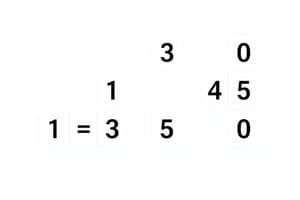Podcast
Questions and Answers
What is the primary purpose of sorting data?
What is the primary purpose of sorting data?
- To enhance data security
- To arrange data in a particular format (correct)
- To increase the size of data files
- To minimize data storage requirements
Which sorting algorithm involves dividing the list into sorted and unsorted sub-lists?
Which sorting algorithm involves dividing the list into sorted and unsorted sub-lists?
- Selection Sort (correct)
- Merge Sort
- Bubble Sort
- Quick Sort
How many passes are required in the selection sort algorithm to completely sort a list of 'n' elements?
How many passes are required in the selection sort algorithm to completely sort a list of 'n' elements?
- n-1 passes (correct)
- n/2 passes
- n passes
- n+1 passes
What does the complexity of a sorting algorithm indicate?
What does the complexity of a sorting algorithm indicate?
Which sorting method is NOT mentioned in the content as a type of sorting?
Which sorting method is NOT mentioned in the content as a type of sorting?
What happens during each pass of the selection sort process?
What happens during each pass of the selection sort process?
In selection sort, what does the 'wall' represent?
In selection sort, what does the 'wall' represent?
What factor is NOT considered when choosing a suitable sorting method?
What factor is NOT considered when choosing a suitable sorting method?
What does the pivot index represent in the quicksort algorithm?
What does the pivot index represent in the quicksort algorithm?
What is the best case running time for quicksort when keys are randomly distributed?
What is the best case running time for quicksort when keys are randomly distributed?
When does quicksort reach its worst case time complexity?
When does quicksort reach its worst case time complexity?
What is the depth of the recursion tree in quicksort for an evenly distributed array?
What is the depth of the recursion tree in quicksort for an evenly distributed array?
Which operation is performed when left index is less than the right index in quicksort?
Which operation is performed when left index is less than the right index in quicksort?
What can be done to avoid the worst-case scenario in quicksort?
What can be done to avoid the worst-case scenario in quicksort?
In the context of quicksort, what does O(n) represent?
In the context of quicksort, what does O(n) represent?
Which of the following statements about quicksort is correct?
Which of the following statements about quicksort is correct?
What is the first step in the process after checking 'While data[left] data[pivot]'?
What is the first step in the process after checking 'While data[left] data[pivot]'?
What condition must be true for the swapping of data[left] and data[right] to occur?
What condition must be true for the swapping of data[left] and data[right] to occur?
Which of the following is a correct condition that restarts the loop process?
Which of the following is a correct condition that restarts the loop process?
After executing 'swap data[left] and data[right]', what process follows next?
After executing 'swap data[left] and data[right]', what process follows next?
What will happen if 'left' is not less than 'right' after the checks?
What will happen if 'left' is not less than 'right' after the checks?
During the data sorting process, if a swap occurs, which indices might need to be adjusted next?
During the data sorting process, if a swap occurs, which indices might need to be adjusted next?
In which situation is it valid to exit the while loop before checking any conditions again?
In which situation is it valid to exit the while loop before checking any conditions again?
What is the significance of the pivot index in this sorting method?
What is the significance of the pivot index in this sorting method?
What is the first condition checked in the sorting process described?
What is the first condition checked in the sorting process described?
What happens when the condition left < right is true?
What happens when the condition left < right is true?
In the sorting algorithm, what does the variable pivot represent?
In the sorting algorithm, what does the variable pivot represent?
Which condition will cause the algorithm to loop back to step 1?
Which condition will cause the algorithm to loop back to step 1?
What would happen if the condition data[left] > data[pivot] returns true?
What would happen if the condition data[left] > data[pivot] returns true?
What is one of the potential outcomes of executing the logic described in the sorting process?
What is one of the potential outcomes of executing the logic described in the sorting process?
During the sorting process, when is data[left] and data[right] swapped?
During the sorting process, when is data[left] and data[right] swapped?
Which statement correctly describes the relationship between the indices left and right during the algorithm's execution?
Which statement correctly describes the relationship between the indices left and right during the algorithm's execution?
What action is taken when the condition 'left < right' holds true?
What action is taken when the condition 'left < right' holds true?
Which condition must be satisfied for the process to continue iterating?
Which condition must be satisfied for the process to continue iterating?
What is the role of the pivot index in the described process?
What is the role of the pivot index in the described process?
What happens if the 'data[left]' value is equal to 'data[pivot]'?
What happens if the 'data[left]' value is equal to 'data[pivot]'?
What is the first operation performed according to the sequence outlined?
What is the first operation performed according to the sequence outlined?
In which scenario is the swapping of 'data[left]' and 'data[right]' executed?
In which scenario is the swapping of 'data[left]' and 'data[right]' executed?
What condition leads to the final swap of 'data[right]' and 'data[pivot_index]'?
What condition leads to the final swap of 'data[right]' and 'data[pivot_index]'?
What is the significance of the 'while' loop in this algorithm?
What is the significance of the 'while' loop in this algorithm?
Flashcards are hidden until you start studying
Study Notes
Quicksort Algorithm Steps
- The algorithm picks a pivot element from an array.
- It partitions the array around the pivot such that all numbers smaller than the pivot are placed to the left of the pivot.
- All numbers greater than the pivot are placed to the right of the pivot.
- Recursively apply steps 1 to 3 to the sub-arrays to the left and right of the pivot.
Partition Step
- The pivot element is fixed at the end of the array.
- Initialize
leftat the beginning of the array. - Initialize
rightone position before the pivot. - While
leftis less thanright, the algorithm checks the following:- If
data[left]is greater thandata[pivot]anddata[right]is greater thandata[pivot], then decrementright. - If
data[left]is greater thandata[pivot]anddata[right]is less than or equal todata[pivot], then swapdata[left]anddata[right], and incrementleftand decrementright. - If
data[left]is less than or equal todata[pivot]anddata[right]is less than or equal todata[pivot], then incrementleft. - If
data[left]is less than or equal todata[pivot]anddata[right]is greater thandata[pivot], then decrementright.
- If
- Swap
data[right]withdata[pivot]to place the pivot element in its correct position.
Quicksort Analysis
- The best-case running time of the quicksort algorithm is O(n log₂n).
- The worst-case running time of the quicksort algorithm is O(n²).
- In the best case, the pivot element always partitions the array into two sub-arrays of approximately equal size. This results in a balanced recursion tree with a depth of O(log₂n).
- In the worst case, the pivot element results in an unbalanced partition, where one sub-array is always empty. This leads to a linear depth recursion tree, resulting in O(n²) time complexity.
- Randomly selecting a pivot element is a strategy to avoid the worst-case scenario where the pivot element is always the smallest or the largest element in the array.
Insertion Sort
- Insertion sort is a simple sorting algorithm that works by iterating through the array, inserting each element into its correct position in the sorted subarray.
- The algorithm maintains two subarrays: a sorted subarray and an unsorted subarray.
- The sorted subarray is initially empty, and the unsorted subarray is the entire input array.
- In each iteration, the algorithm takes the first element from the unsorted subarray and inserts it into the sorted subarray at the correct position.
- The algorithm repeats this process until the unsorted subarray is empty.
Selection Sort
- Selection sort works by repeatedly finding the minimum element from the unsorted part of the array and swapping it with the element at the beginning of the unsorted part.
- The algorithm maintains two subarrays: a sorted subarray and an unsorted subarray.
- The sorted subarray is initially empty and the unsorted subarray is the entire input array.
- In each iteration, the algorithm finds the minimum element from the unsorted subarray and swaps it with the element at the beginning of the unsorted subarray.
- The algorithm repeats this process until the unsorted subarray is empty.
Studying That Suits You
Use AI to generate personalized quizzes and flashcards to suit your learning preferences.





